Table of contents
Subscribe to our newsletter
Thank you! Your submission has been received!
Oops! Something went wrong while submitting the form.


Most professional services firms are losing money. Not because their people aren’t skilled, or their clients aren’t valuable, but because they can’t see what’s actually going on inside their own business.
In fact, firms across accounting, engineering, architecture and consulting are haemorrhaging revenue each year due to what we’ll call visibility gaps. These are the blind spots between projects, people and profitability – the kind of things you don’t notice until a deadline is missed, an invoice goes unbilled, or your top talent burns out.
And the worst part is that most firms don’t even realise it’s happening.
In this article, we’ll unpack where these gaps come from, how much they really cost you, and what to do if you’d prefer not to keep throwing money into the abyss.
A visibility gap is the space between what leaders believe is happening inside the business and what’s actually going on. It's the blind spot created when data lives in silos, updates arrive too late or managers rely on intuition instead of facts.
In professional services firms these gaps creep in quietly and surface in whats that are easy to dismiss - until the consequences are too large to ignore:
Even small blind spots like these, can add up to major financial loss in the long run
Example:
Imagine a 50-person consulting firm billing R1000,00 per hour. If just 10% of billable time goes untracked or unbilled, that R500,000 lost every month - more than R6 million in a single year.
And that's only the lost billings you can put a number on. The harder-to-measure costs are often worse:
When visibility is missing, the firm may look busy on the surface, but it is rarely building sustainable profitability underneath.

Most visibility issues aren’t caused by a lack of effort. They come from the way professional services firms are set up, often stitched together with spreadsheets and standalone tools.
You’ve got one system for accounting, another for project tracking, a separate one for timesheets, and maybe a few rogue Google Sheets floating in someone’s inbox. Each tool might work fine on its own, but none of them talk to each other, which means no one gets the full picture.
Leadership ends up relying on gut feel or half-updated reports. Project managers make decisions in the dark. Teams don’t always know what’s billable and what’s not. By the time the numbers are in, the damage is already done.
This is what happens when there’s no single source of truth, data gets delayed, and decisions become reactive. You end up spending far more time looking backwards than you do planning ahead.
As a result, everyone’s working hard but no one knows if the firm is actually moving in the right direction.
Don’t worry though, there IS good news too.
Visibility gaps don’t exist because firms aren’t trying hard enough. They happen because the tools in place don’t fit the way professional services really run. Adding more software only makes the problem worse. What you really need is one platform (like Magnetic) that connects the dots across the entire business.
You need three things working together:
1. Centralised project and resource management
You shouldn’t have to switch between multiple tools just to see how project and resource data connect. Bringing everything together into one platform makes it easier to track progress, balance workloads across your team and spot risks early in the project lifecycle.
2. Real-time dashboards - Financial and operational data should never be something you have to “go and find”. Financial and operational data should be visible in real time, so you can see where you stand on revenue, billable hours and project progress in one glance.
3. Integrated reporting that actually helps you decide
Data isn’t useful if it sits in a silo. You need reporting that connects the dots between your projects, your people, and your profits in a way that helps you make smart decisions without pulling in a consultant.
Magnetic is an all-in-one professional service (PSA) platform built for firms that need a clear view of profitability and visibility into how different parts of the business fit together, without relying on multiple tools. Instead of running projects in one place, timesheets in another and project financials elsewhere, Magnetic brings everything into one connected system.
Here's how it closes the visibility gaps that cost firms millions
With everything in one place, firms stop losing money in the gaps between systems. Leaders movre from chasing down information to making proactive decisions informed by live, accurate data. Teams spend less time on admin and more on client work. And clients benefit from smoother delivery and projects that meet deadlines.
When you can see the whole picture you protect profitability and create room for growth.
Once a firm sees the full picture, they adapt quickly. The difference shows up in smoother delivery, stronger margins and more deliberate decision making.
Instead of discovering problems when it’s already too late, leaders catch inconsistencies early, and adjust before deadlines and projects are at risk. Team capacity is no longer guesswork - you can see who is at capacity and who has room to take on more work. Forecasts stop being optimistic estimates and start reflecting the reality of your pipeline and resources. The outcome is a business that runs with greater predictability, more balanced teams and profitability that is protected.
Here’s what that looks like in practice:
Take Exonic Solutions for example – Johannesburg‑based consultancy. They replaced multiple siloed tools with Magnetic and saw dramatic improvements:
“We’ve seen the value firsthand. Magnetic has helped us replace the noise of multiple tools with a single, reliable system that actually supports how we work.”
– Billy Einkamerer, Managing Director, Exonic Solutions
Visibility gaps don't usually show up as dramatic failures. They don’t break systems or send clients rushing for the exit. Instead, they hide in the background - in unbilled hours, overrun projects and missed opportunities - until they’ve chipped away at both profit and morale.
The firms that grow are the ones who see what’s happening in real time and act on it. They know which projects are on track, which teams are over capacity, and where revenue is being won or lost.
Magnetic gives you a single integrated view of your people, projects and profits - so you can make decisions that grow the business instead of patching leaks.
Schedule a demo and see how Magnetic helps firms like yours close visibility gaps and recover lost revenue.
A visibility gap is the blind spot between what leaders think is happening in the business and what’s actually going on. It usually shows up when data is scattered across spreadsheets and systems that don’t connect, leading to missed hours, uneven workloads, and inaccurate forecasts.
.svg)
Even small gaps can compound quickly. Missed billable hours, delayed invoices, and uneven resourcing eat into margins every month. Over time, these hidden losses can add up to millions in revenue leakage.
.svg)
Full visibility means you can see projects, people, and profits in one place. Leaders know which projects are on track, which teams have capacity, and what the financial impact will be—all in real time.
.svg)
Spreadsheets and disconnected tools only give part of the picture. By the time data is pulled together, it’s often out of date. Leaders end up relying on gut feel instead of facts, which makes decision-making reactive rather than proactive.
.svg)
Magnetic brings projects, timesheets, forecasting, finance, and reporting into one connected platform. That means no more sourcing updates across multiple systems - everything you need to run a profitable firm is in one view.
.svg)
Magnetic is built for professional services firms - consulting, engineering, architecture, accounting, and agencies - where profitability depends on balancing projects, people, and billable time. Any firm that needs to track utilisation, delivery, and financials in real time will see value.